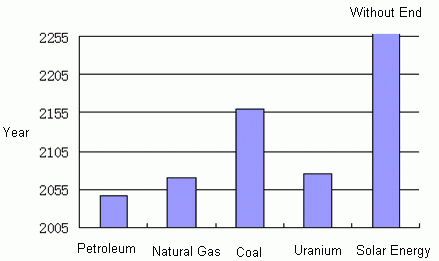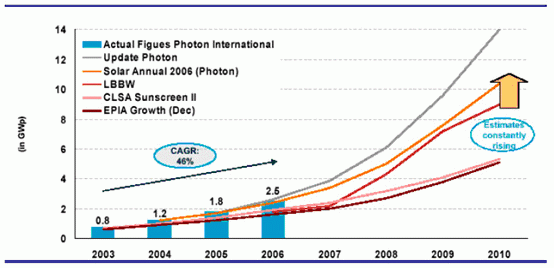| |
|
 |
PV industry witnessed a rapid growth, and in the future it will have a nearly limitless outlook. During the ten years from 1996 to 2006, yield of solar batteries in the world has increased by 26 times with annual compound growth rate of 38%. Besides, annual installations of solar batteries have increased by 22 times with annual compound growth rate of 36%. Such a growth is too speedy to compare for any other industries except for semi-conductor industry. Though Germany is today's largest PV market, but solar power generation there still takes a low proportion of 0.5%. But solar energy will undoubtedly become one kind of mainstream energy; therefore, its market will witness a bright prospect in the long term.
Exhaust Year for Traditional Energy (Estimated by Proved Reserves and Current Consumption Speed)

From 2020 to 2030 solar energy will enter into mainstream energy market on a large scale. Technical progress together with scale effects will steadily reduce the cost of PV batteries. Curve figures of PV industry in the past 40 years have shown that cost will down 15-20% once accumulated sales volume of PV batteries is doubled. Meanwhile, power generation cost with fossil fuel has been increasing for a long term. We estimated here by different geographic locations, that solar power generation cost in developed countries will approach electricity prices for the peak period from 2010 to 2030; and it will approach average electricity prices from 2020 to 2050.
Anticipations for Endlessly Increasing PV Batteries Yield in the World

Promotion from governments will still be the leading strength for industry development in the short run. Undoubtedly, The government plays a key role in boosting PV industry. Europe, USA and Japan all have recognized the importance of strategy to develop PV industry and they all have plans of their own. But the real development of the industry usually doesn't fit well with these plans. It's believed that existing policy in each country has established gigantic potential demands; and decline in growth speed in 2006 is caused by that growth of battery price has restrained demands. Therefore, as long as battery prices properly declines, growth of installed capacity can exceed 30%.
China PV industry focuses more on midstream and downstream businesses; and it will confront with considerable inconveniences on entry into upstream polysilicon business. China PV batteries list the 3rd in the world by production capacity; however, polysilicon raw materials and markets all lie in overseas market and domestic industrial structure is very irrational. Now market competition is fiercer and fiercer, and competitiveness of Chinese enterprises still lies in the cost. Undoubtedly, advantages for leading enterprises with long-term polysilicon orders will be enlarged; while enterprise with no strengths will be eliminated. Many investors are attracted by the huge profits. However, very few projects that can really bring economic profits.
It is believed in the next few years, companies with sufficient polysilicon supply and manufacturers of amorphous silicon PV battery would obtain broad development space. As for crystalline silicon PV battery producers, only the strong can survive competition and gain more strength. Therefore PV enterprises with international resource and internet strength will particularly develop well. Film PV battery companies industrialized will enjoy a greater developing space, which will naturally draw much interest from investors.
|
|
|
|
|
If this report could not still meet your requirement, or
you have any comments or suggestions on it, please leave a
message to us.
|
2005-2007 www.researchinchina.com All Rights Reserved
| |
|
 |
| |
|
PV industry witnessed a rapid growth, and in the future it will have a nearly limitless outlook. During the ten years from 1996 to 2006, yield of solar batteries in the world has increased by 26 times with annual compound growth rate of 38%. Besides, annual installations of solar batteries have increased by 22 times with annual compound growth rate of 36%. Such a growth is too speedy to compare for any other industries except for semi-conductor industry. Though Germany is today's largest PV market, but solar power generation there still takes a low proportion of 0.5%. But solar energy will undoubtedly become one kind of mainstream energy; therefore, its market will witness a bright prospect in the long term.
Exhaust Year for Traditional Energy (Estimated by Proved Reserves and Current Consumption Speed)

From 2020 to 2030 solar energy will enter into mainstream energy market on a large scale. Technical progress together with scale effects will steadily reduce the cost of PV batteries. Curve figures of PV industry in the past 40 years have shown that cost will down 15-20% once accumulated sales volume of PV batteries is doubled. Meanwhile, power generation cost with fossil fuel has been increasing for a long term. We estimated here by different geographic locations, that solar power generation cost in developed countries will approach electricity prices for the peak period from 2010 to 2030; and it will approach average electricity prices from 2020 to 2050.
Anticipations for Endlessly Increasing PV Batteries Yield in the World

Promotion from governments will still be the leading strength for industry development in the short run. Undoubtedly, The government plays a key role in boosting PV industry. Europe, USA and Japan all have recognized the importance of strategy to develop PV industry and they all have plans of their own. But the real development of the industry usually doesn't fit well with these plans. It's believed that existing policy in each country has established gigantic potential demands; and decline in growth speed in 2006 is caused by that growth of battery price has restrained demands. Therefore, as long as battery prices properly declines, growth of installed capacity can exceed 30%.
China PV industry focuses more on midstream and downstream businesses; and it will confront with considerable inconveniences on entry into upstream polysilicon business. China PV batteries list the 3rd in the world by production capacity; however, polysilicon raw materials and markets all lie in overseas market and domestic industrial structure is very irrational. Now market competition is fiercer and fiercer, and competitiveness of Chinese enterprises still lies in the cost. Undoubtedly, advantages for leading enterprises with long-term polysilicon orders will be enlarged; while enterprise with no strengths will be eliminated. Many investors are attracted by the huge profits. However, very few projects that can really bring economic profits.
It is believed in the next few years, companies with sufficient polysilicon supply and manufacturers of amorphous silicon PV battery would obtain broad development space. As for crystalline silicon PV battery producers, only the strong can survive competition and gain more strength. Therefore PV enterprises with international resource and internet strength will particularly develop well. Film PV battery companies industrialized will enjoy a greater developing space, which will naturally draw much interest from investors.
|
|
|
|
|
2005-2006 www.researchinchina.com All Rights Reserved |
|
| |
|
 |
| |
|
1 Solar Energy is the Inevitable Energy Choice
1.1 Only Solar Energy can satisfy Future Energy Demands
1.2 Solar Energy is to enter into Mainstream Energy Market in 2020-2030
2 Supply and Demand Analysis on Global PV Market
2.1 Governments will still be the Leading Strength to boost Industry Development for a medium and long term
2.2 Existing Policies will boost Rapid Development of PV Market
2.3 Active Production Expansion by Battery Manufacturers, and Ample PV Batteries Production Capability
2.4 Polysilicon Supply Crisis is to start loosing at the end of 2008 3 PV Industry Chain
3.1 Pyramid Distribution has brought advantages of Upstream Enterprises
3.2 Competition Status
3.3 Optimization of Industry Chain will bring Cost Decline 4 China Solar Energy Industry
4.1 Most Enterprises Invested in Polysilicon
4.2 Difficulties in Starting China Market in the next few years
4.3 Relevant Listed Companies
|
|
|
|
|
2005-2006 www.researchinchina.com All Rights Reserved |
|
| |
|
 |
| |
|
Annual Installed Capacity and Growth Rate of Global Solar Batteries
Yield and Growth Rate of Global Solar Batteries
Exhaust Year of Conventional Energy (Estimated by Proved Reserves and Current Consumption Speed)
Global Energy Consumption Structure Prospect
Decline Curve for PV Battery Cost
Changes in Electricity Prices for Residents in Developed Countries
Comparison between Solar Power Generation Cost (changing with Geographic Location) and Electricity Prices for Residents
Electricity Consumption Cycle of Typical Spanish Buildings and PV Battery Power Generation Cycle
Future Expectations of PV Power Generation Cost, Peak-period Electricity Prices and Average Electricity Prices
Solar Battery Industry Chain
Effects of Policies by German Governments on Solar Energy PV Industry
Changes in Annual Installed Capacity for Markets in Different Countries
Growth Rate of Annual Installed Capacity for Markets in Different Countries
Comparison of Proportions of Annual Installed Capacity in Global PV Market, by country
Comparison of Accumulated Installed Capacity between IEA PVPS Countries
Production Capability Utilization Rate in Solar Battery Industry
Comparison of Yield, Shipment and Installations between Global Solar Batteries
Global Solar Battery Production Capability Distribution in 2005 Gross Production Capability: 2.3GW
Global Solar Battery Production Capability Distribution in 2006 Gross Production Capability: 3.2GW
Proportions of Shipment in 2005 (Total Quantity of 1407MW)
Proportions of Shipment in 2006 (Total Quantity of 1982MW)
Sources of Solar Energy Polysilicon in 2005 (Total Quantity of 19,800 tons)
Retail Prices Trend of 125W-above level Solar Battery Modules
Comparison between Crystalline Silicon Synthesis Routes
Market Shares of Polysilicon Manufacturers in 2005 Gross Production Capability:31,280 tons
Comparison between Forecasted Polysilicon Supply and Assumptive Yield
Delicately Balanced PV Market under Multi-factor Functions
Expectations of Endlessly Increasing PV Battery Yield in the world
Sustaining Decline of Silicon Slice Thickness and Silicon Consumption for per tile
Main Line of Crystalline Silicon Solar Battery Industry Chain
Crystalline Silicon Solar Energy Industry Chain: from Raw Materials to Systems
Production Process of Crystalline Silicon Solar Energy
Changes in Profit Margin for Different Links of Solar Batteries
Growth of Q-Cells
Cost Structure of Solar Battery System in 2005
Greenhouse Gasses Discharge of Different Power Generation Modes (Converted into CO2)
Energy Recovery for Different Solar Battery Technologies
Supporting Policies and Objectives for Solar Energy PV Industry in Different Countries
Production Capability Expansion of Different Large-scale Polysilicon Manufacturers (including Electronics Grade Polysilicon)
Polysilicon Project Plan for Newly-entering Manufacturers
Expectations of Endlessly Increasing PV Battery Installed Capacity in the world
Pyramid Distribution of Crystalline Silicon Solar Battery Industry Chain
Estimations Comparison between Different International/National PV Enterprises
China Solar Energy Industry Chain Distribution
Polysilicon Projects in China
Incomplete Statistics of Polysilicon Production Status and Investment
China Listed Companies Profile in Relevant Industry with Solar Battery Industry
Segmented Market and Functions for Solar Batteries
|
2005-2008 www.researchinchina.com All Rights Reserved
|



